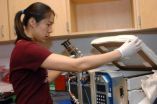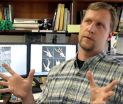(Press-News.org) The University of Colorado Boulder is involved with five different space science payloads ranging from antibody tests that may lead to new bone-loss treatments to an experiment to improve vaccine effectiveness for combating salmonella when Atlantis thunders skyward July 8 on the last of NASA's 135 space shuttle missions.
One experiment, sponsored by the global pharmaceutical companies Amgen and UCB, will test an antibody to sclerostin -- a protein that has a negative effect on bone formation, mass and strength -- on lab mice flying on the shuttle. Researchers on the project hope the sclerostin antibody treatment will inhibit the action of sclerostin.
The research team hopes the findings may lead to potential therapeutic treatments for astronauts, who suffer significant bone loss during spaceflight, especially on long-term missions. They also might provide insight for future research in the prevention and treatment of skeletal fragility that may be caused by stroke, cerebral palsy, muscular dystrophy, spinal cord injury and reduced physical activity. Amgen is headquartered in Thousand Oaks, Calif., while UCB is headquartered in Brussels, Belgium.
There are seven co-principal investigators on the sclerostin antibody experiment, including Louis Stodieck, director of CU-Boulder's BioServe Space Technologies and a faculty member in the aerospace engineering sciences department. The research team includes a second CU-Boulder co-principal investigator, Assistant Professor Virginia Ferguson of mechanical engineering, an expert in biomaterials, including bone.
A second payload, called the Recombinant Attenuated Salmonella Vaccine, or RASV, will allow scientists to search for novel gene targets for vaccine development and improvement using the low gravity of space. The principal investigator on the experiment is Associate Professor Cheryl Nickerson of Arizona State University.
The RASV experiment will be carried aboard Atlantis in sets of specially designed fluid-processing cylinders built by BioServe known as GAPs, said Stodieck. Each GAP holds eight test-tube-like devices that allow Salmonella and growth media to be mixed in space. Astronauts will operate the experiments using hand cranks to first trigger cell growth via fluid mixing and later to terminate it.
A third payload will allow researchers to examine genetic alterations spurred by cellular changes in yeast. Since some cells have been shown to undergo significant changes in microgravity -- like producing larger quantities of rare antibiotics or making large amounts of bioactive medicinal proteins -- the team will analyze 6,000 different genetically altered yeast strains aboard the payload to identify specific genes that are linked to such space-based changes. This knowledge could someday help efforts to produce new and better medicines, said Stodieck.
Led by Timothy Hammond of the Veteran's Administration in Washington, D.C., the payload will be flown inside two types of BioServe flight hardware known as an opticell processing module and a plate habitat that rides inside a BioServe Generic Bioprocessing Apparatus, or CGBA. The CGBA is an automated, suitcase-sized device developed by CU-Boulder that has been launched on more than 20 NASA space shuttle missions and which provides steady temperature control. There currently are two BioServe CGBA devices on the International Space Station, one of which will be used for processing the yeast experiment at an elevated temperature.
A fourth payload involving biofilms may help scientists understand how and why slimy and troublesome clumps of microorganisms flourish in the low-gravity conditions of space. The experiments on biofilms -- clusters of microorganisms that adhere to each other or to various surfaces -- are of high interest to space scientists because of their potential impacts on astronaut and spacecraft health, said Stodieck.
Led by Professor Cynthia Collins of Rensselaer Polytechnic Institute in Troy, N.Y., the biofilm experiment riding inside a second BioServe CGBA will target the growth, physiology and cell-to-cell interactions in microbial biofilms. The team will examine how the formation of the three-dimensional structure of biofilms formed by microbes differs in spaceflight versus normal gravity.
A fifth payload will be used to assess the effects of microgravity on the formation, establishment and multiplication of cells in a tropical plant known as Jatropha that produces energy-rich nuts, a popular new renewable crop for biofuels. The team will be looking for genes that help or hinder Jatropha growth to see if new strains can be developed and commercially grown in "warm-temperate" areas like the southern United States. The lead scientist on the experiment is Associate Professor Wagner Vendrame of the University of Florida.
BioServe is a nonprofit, NASA-supported center founded in 1987 at CU-Boulder to develop new or improved products through space life science research in partnership with industry, academia and government. Since 1991 BioServe has flown payloads on 37 NASA space shuttle microgravity missions.
Although NASA's space shuttle program will be shuttered following the Atlantis mission, hardware and experiments developed by BioServe are manifested on various international resupply vehicles traveling to the International Space Station, as well as on U.S. spacecraft now under development, said Stodieck.
"We would be unable to carry out all of our research without the help of CU-Boulder students," he said. "Both undergraduate and graduate students play an important role in designing, building and testing spaceflight payloads, activities that can give them a significant advantage when they move on to careers in the aerospace industry."
BioServe also has flown several K-12 educational experiments on the space station, including seed-germination studies, spider web-weaving experiments, butterfly life cycle experiments and crystal garden growth experiments -- all of which have provided learning opportunities for thousands of middle school and high school students around the world. The K-12 efforts have been led by Stefanie Countryman, BioServe's business manager and coordinator of education outreach.
INFORMATION:
For more information on BioServe visit http://www.colorado.edu/engineering/BioServe/index.html.
Final space shuttle to carry 5 CU-Boulder-built payloads
2011-07-07
ELSE PRESS RELEASES FROM THIS DATE:
Eggs may help prevent heart disease and cancer
2011-07-07
One of nature's most perfect foods may be even better for us than previously thought.
While eggs are well known to be an excellent source of proteins, lipids, vitamins and minerals, researchers at the University of Alberta recently discovered they also contain antioxidant properties, which helps in the prevention of cardiovascular disease and cancer.
Jianping Wu, Andreas Schieber and graduate students Chamila Nimalaratne and Daise Lopes-Lutz of the U of A Department of Agricultural Food and Nutritional Science examined egg yolks produced by hens fed typical diets of ...
Self-paced walking test useful for evaluating progress in lifestyle intervention programs
2011-07-07
HOUSTON- (July 5, 2011) - The self-paced walking test, known as the 400-meter walk test, is effective in measuring improved physical function in postmenopausal women who have lost weight through healthy physical activity and dietary changes, according to collaborative research conducted by The University of Texas Health Science Center at Houston (UTHealth) and The University of Pittsburgh.
"The 400-meter self-paced walk test is a simple, cost-efficient and effective test clinicians or researchers can use to evaluate progress in a weight loss or physical activity program," ...
Being small has its advantages, if you are a leaf
2011-07-07
The size of leaves can vary by a factor of 1,000 across plant species, but until now, the reason why has remained a mystery. A new study by an international team of scientists led by UCLA life scientists goes a long way toward solving it.
In research federally funded by the National Science Foundation, the biologists found that smaller leaves are structurally and physiologically better adapted to dry soil because of their distinct vein systems.
The research will be published in an upcoming print issue of the journal Plant Physiology and is currently available in ...
USC researchers link genetic marker to rectal cancer treatment
2011-07-07
A team of researchers led by Keck School of Medicine of the University of Southern California (USC) oncologist Heinz-Josef Lenz, M.D., has identified a genetic marker that may predict which patients with rectal cancer can be cured by certain chemotherapies when combined with surgery. The discovery, scheduled for publication in the August 1 edition of Clinical Cancer Research, brings doctors closer to customizing cancer treatment to individual patients.
Lenz, professor of medicine and preventive medicine in the division of medical oncology at the Keck School and the study's ...
Old life capable of revealing new tricks after all
2011-07-07
Archaea are among the oldest known life-forms, but they are not well understood. It was only in the 1970s that these single-celled microorganisms were designated as a domain of life distinct from bacteria and multicellular organisms called eukaryotes.
Robert Gunsalus, a UCLA professor of microbiology, immunology and molecular genetics, developed an interest in Archaea because of their ability to thrive in harsh environments. Now, using state-of-the-art imaging equipment at the California NanoSystems Institute (CNSI) at UCLA, he has shown for the first time that a type ...
Ruminant headgear: A mystery awaiting unraveling
2011-07-07
EUGENE, Ore. -- Emerging from the heads of most cud-chewing mammals, headgear inspire an almost mystical and certainly majestic aura. But, scientists say, we know shockingly little about them.
In a paper appearing online ahead of regular publication in the Proceedings of the Royal Society B, a London-based international journal dedicated to biology, a three-member scientific team spells out what is known -- and not known -- about antlers, horns, pronghorns and ossicones.
For antlers, think deer, moose and elk. Horns are worn by cattle, sheep and goats; ossicones by ...
Gene therapy stimulates protein that blocks immune attack and prevents Type 1 diabetes in mice
2011-07-07
Increasing a specific protein in areas of the pancreas that produce insulin blocks the immune attack that causes type 1 diabetes, researchers reported in the August issue of the Journal of Clinical Investigation, published early online.
The discovery could lead to a drug that prevents the progression of type 1 diabetes in people newly diagnosed who are in the "honeymoon" phase of the disease, when the immune system has not yet destroyed all of the insulin-producing beta cells in the pancreas.
The finding could also lead to new drugs for overcoming organ rejection in ...
Childhood asthma linked to depression during pregnancy
2011-07-07
July 5, 2011– Anxiety, stress and depression during pregnancy may lead to a greater risk of asthma for your child, according to researchers at Columbia University's Mailman School of Public Health. Study results are published in the July issue of Annals of Allergy, Asthma & Immunology, the scientific journal of the American College of Allergy, Asthma and Immunology (ACAAI).
"Approximately 70% of mothers who said they experienced high levels of anxiety or depression while they were pregnant reported their child had wheezed before age 5," said Marilyn Reyes, senior research ...
Just add water and treat brain cancer
2011-07-07
Researchers at the Johns Hopkins University School of Medicine have developed a technique that delivers gene therapy into human brain cancer cells using nanoparticles that can be freeze-dried and stored for up to three months prior to use. The shelf-stable particles may obviate the need for virus-mediated gene therapy, which has been associated with safety concerns. The report appears in the August issue of Biomaterials.
"Most nonviral gene therapy methods have very low efficacy," says Jordan Green, Ph.D., an assistant professor of biomedical engineering at Johns Hopkins. ...
IVF 'vanishing twin' linked with birth defects
2011-07-07
A significant discovery by University of Adelaide researchers shows that the loss of a twin during early pregnancy explains the increased risk of birth defects in multiple IVF pregnancies.
The annual meeting of the European Society of Human Reproduction and Embryology in Stockholm today will hear Associate Professor Michael Davies explain how the "vanishing twin" phenomenon is linked to a nearly two-fold increased risk of congenital malformation in the surviving baby, and a threefold increase in multiple birth defects.
The phenomenon occurs when there are fewer babies ...

